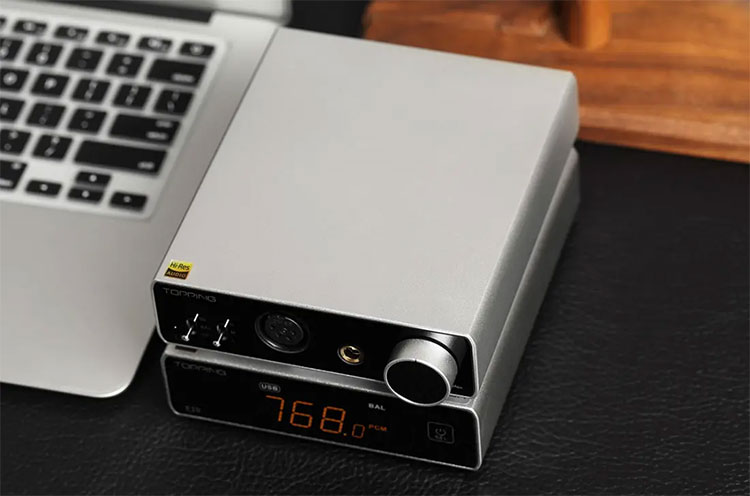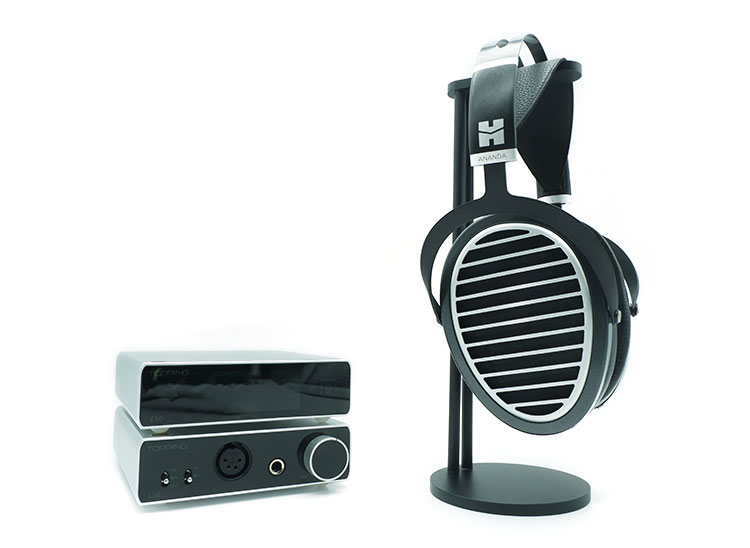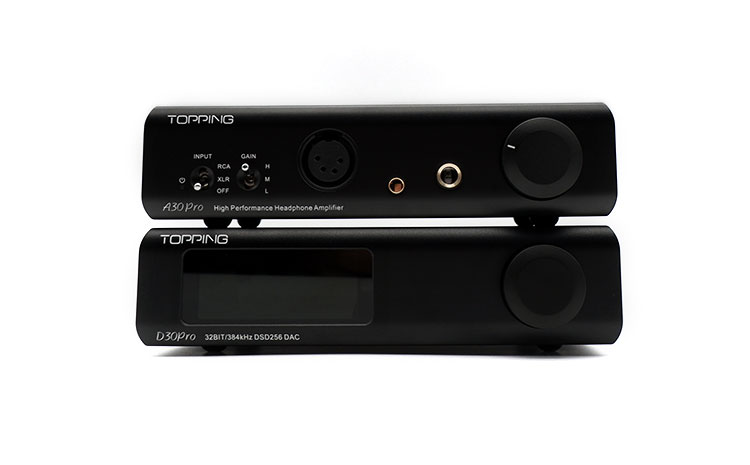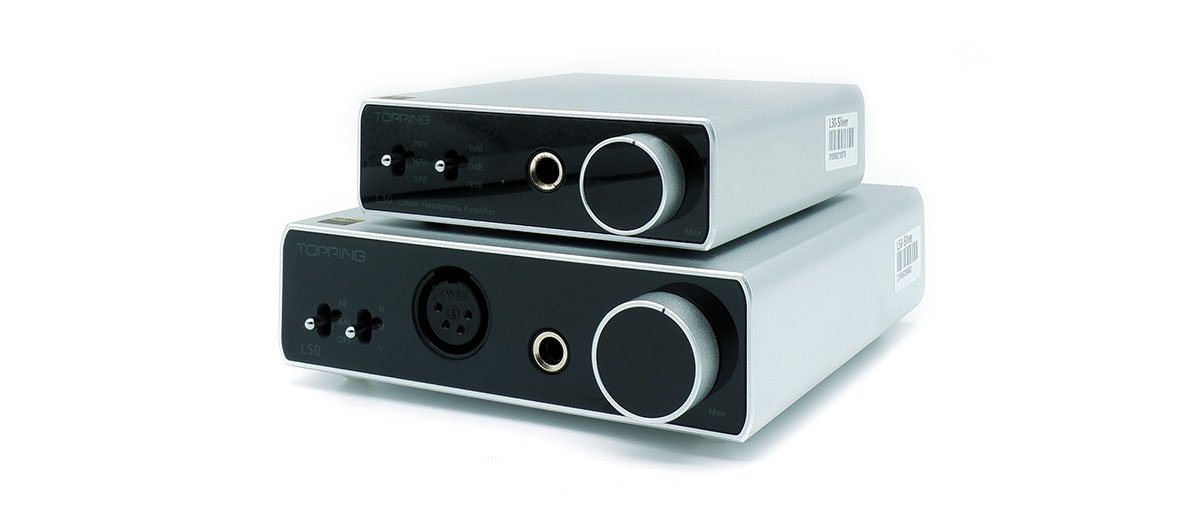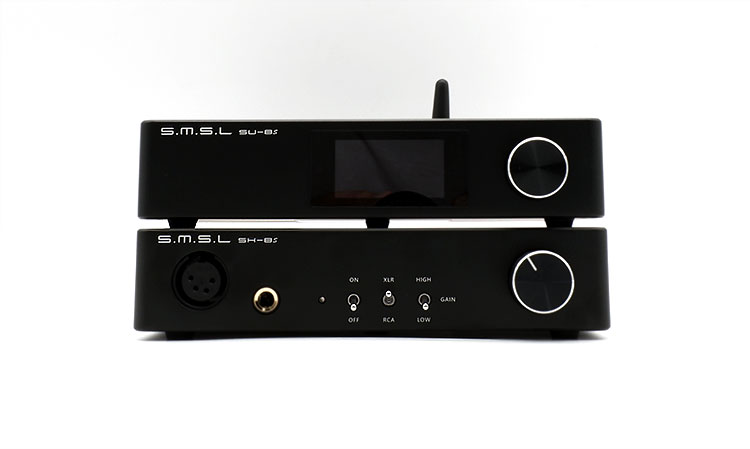Synergy
Power
Since the L50 is rated at 3.5W into 16Ω through both the balanced and single-ended outputs, it can easily manage most headphones that I connect to it.
With the Sennheiser HD600, I only needed to reach 12 o’clock on medium gain to reach my comfortable listening levels. With planar magnetic headphones such as the Hifiman Ananda, I only needed to crank it up to 10 o’clock on medium gain to reach my normal listening levels.
On the flip side, the L50 is still quiet enough to power my IEMs without any issue. With the FiiO FH3 in particular, there is no audible hiss even when I crank it up to maximum with high gain, which isn’t a realistic listening level at all. In reality, I only listen to around 11 o’clock on low gain for the FD3, so I’m sure that the L50 can easily run IEMs without any hiss.
Matchability
Physically, the E50 and L50 are a perfect match, since their aesthetics are quite similar. More importantly, however, the E50 and L50 sonically complement each other, as the L50’s better sense of space breathes more life into the E50’s flatter soundscape. Also, the control that the E50 provides doesn’t get in the way of the dynamic contrast that the stack is capable of.
At first, I thought that the honesty of the E50 and L50 might end up being too much of a good thing, but it turned out well for the pairing. This allows the pair to simply get out of the way of presenting what the track intends to show.
Interestingly, the tonal balance of the E50 and L50 also balance each other well, where the thicker presentation on the L50’s bass makes up for a slower sense of attack with the E50. Furthermore, the more honest midrange on both units simply combines to give that hint of euphony that makes the music remain natural while being pleasant overall.
Pairing
The first headphone that I tested with the stack I the HarmonicDyne Poseidon. It ended up being a relatively good pair allowing the warmer tonality and more full-bodied midrange to make up for a more relaxed midrange on the E50/L50 stack. However, what ultimately lead me to believe that this isn’t the best match is the lack of soundstage width and depth.
So I decided to take out the Austrian Audio Hi-X65, which is a wider headphone with a more neutral presentation. This allowed the Hi-X65 and the Topping stack to play to each other’s strengths, as the decay and sense of space on the Hi-X65 remain natural while the tonal embellishments of the stack make it a more fun listen overall.
However, the most interesting pair that I found with the E50/L50 is the Hifiman Ananda, where the sense of space and width breathed air into the presentation. This pair also allowed a sense of layering and space to be more apparent without being artificial.
Tonally, this pairing also works well, since Ananda doesn’t have an immediate sense of attack, so the more pronounced midbass character will give it that illusion of palpability. The flatter tonal character of the Ananda also allows the midrange to have a planted fundamental while having that hint of euphony that makes the presentation sweeter overall.
Select Comparisons
Topping A30 Pro & D30 Pro
$349.99 & $399.99
Technical
While both stacks come from the same company, the internals, particularly of the DACs in the 2 stacks are very different. With the D30 Pro, Topping opted to use 4xCS43198, together with an XMOS XU208 USB controller.
This combination limits the D30 Pro’s decoding capabilities to 32bit/384kHz and DSD256 while lacking any MQA decoding capability. Based on the specs, the measured THD+N on the D30 Pro is a lower 0.0004%, while having a wider dynamic range of 132dB.
According to the device specifications, it says that the L50’s NFCA topology is widely based on the A30 Pro which results in both amplifiers achieving a similar 0.3µV noise floor. However, the A30 Pro is designed to be a more powerful device, being capable of 6W into 16Ω.
Design
When it comes to aesthetics, the 2 stacks are pretty different, with the A30 Pro/D30 Pro having more aluminum parts in its chassis that seem to be more meticulously machined. Then there’s the power cable, where the A30 Pro/D30 Pro stack has internal power supplies that means that both devices can use standard IEC power cables instead of bulky wall warts on the E50/L50 stack.
Surprisingly, the 2 stacks take up about the same amount of desk space but the A30 Pro/D30 Pro stack is wider and more shallow. This gives the initial impression that the A30 Pro/D30 Pro stack may seem like it takes up more space comparatively.
While it seems like the 2 stacks are very different on the surface, the controls and ports used on both stacks are very similar. Both DACs have a 7 segment display, and while the D30 Pro has a volume knob, the control functions with the volume knob are still very limited. Also, both DACs can be controlled more easily using the remote control.
When it comes to the amplifiers, both amps have the same toggle switch controls with similar options. However, the A30 Pro has an additional 4.4mm balanced pentaconn output.
At the rear, the input and output options of the stacks are pretty much the same. Where the most notable difference can be found with the balanced interconnect cables that are to be used. I believe that the balanced connectors that are used on the A30 Pro/D30 Pro stack are much more convenient since 3-pin balanced XLR is more common in our market.
Performance
Despite both stacks coming from the same company, there are some contrasts in how the 2 stacks interpret the music. With the A30 Pro/D30 Pro, it creates a thicker and more full-bodied presentation particularly in the mid-bass response where drum hits take on a more forward and rounded character while being similarly textured.
Going into the vocal range, the A30 Pro/D30 Pro stack creates a more euphonic vocal presentation which may sometimes seem more manicured. However, when it comes to presenting piano passages, the tinkling of the piano keys is more percussive and full-bodied making each keystroke sound more natural.
While neither stack has a particularly forward treble range, the one on the A30 Pro/D30 Pro has a better sense of bite with cymbal hits and wind instruments. Both stacks are equally extended on the top end, so the presentation of air around each image within the soundscape is equally prominent.
The A30 Pro/D30 Pro staging is more expansive allowing more instruments to breathe better since each image is separated more distinctly. However, when it comes to the layering within the soundstage, both stacks perform at a similar level.
Surprisingly, when it comes to presenting dynamic range, both stacks performed at a similar level. I would even dare say that the A30 Pro/D30 Pro leans on playing a bit louder while lacking the gentleness to play softer passages with the proper finesse comparatively.
Topping L30
$139.00
Technical
When I initially skimmed through the specs sheet of these E50 and L30, I was surprised to see that they have similar specs. Particularly with both amplifiers having the same NFCA topology and the same rated output of 3.5W into 16Ω.
However, taking a closer look at the rest of the specifications, shows that the L30 is a step behind its newer stablemate. With the power outputs, the L30 drops off more quickly as we go to higher impedances, being rated at just 280mW into 300Ω, or about half the L50.
The other specification of note is that the L30’s THD+N is measured at 0.00007% while having a comparable dynamic range measured at 141dB.
While the L30 can be perceived as a step behind because of the specifications and the fact that it’s only limited to single-ended operation, there is 1 aspect that the L30 has an edge. It’s the fact that the rear outputs on the L30 work as a decent pre-amp section instead of simply a passthrough connection of downstream devices.
Design
Looking at the 2 devices, there is a lot of family resemblance, and the 2 amplifiers look like different sizes of the same device. However, the L30 is much simpler having only single-ended inputs and outputs, has only a ¼” input connection without any other means to connect a headphone.
At the rear, they even use the same 15V AC power adaptor which is interchangeable between the 2 devices. Again the L30 just has a simpler connection being limited to single-ended operation so it just has 2 pairs of RCA connectors, 1 pair for input, and the other for its preamp output.
Performance
With the 2 devices having so much in common, it comes as no surprise that they also have a lot of sonic similarities. They are similarly lively, allowing some midrange warmth while maintaining an edgy treble presentation.
However, when it comes to the finer details in the presentation, the L30 is a step behind with textures being less defined with the L30. Starting from the bass, there is a more rounded and glossed-over character while maintaining a similar amount of control over the bass response.
When it comes to the vocal presentation, the L30 is less textured and chiseled, making vocals sound more glossed over. However, the L30 adds a hint more euphony, making both male and female vocal sounds comparatively sweeter.
While the treble on the L30 is equally forward, the edginess and the textures from wind instruments are not as readily available. This makes the L30 a bit glossed over while ultimately lacking that last bit of detail.
The most prominent difference between the 2 amplifiers though is the way that images are separated within the soundstage. While the sound stage width and depth are similar on both devices, the images that are formed with the L30 are just more congested while having more overlap between the images.
SMSL SU-8s & SH-8s
$359.99 & $229.99
Technical
The 2 stacks come from different companies, but the 2 DACs in this stack use the same ES9068AS DA converter and XMOS XU216 USB controller. This leads me to believe that there would be some overlap in sonic qualities between the 2 stacks.
When it comes to the decoding capabilities, the 2 DAC sections are similar with both DACs capable of 32bit/768kHz PCM, DSD 512, and even MQA decoding. The measurements of both DACs are even the same with a THD+N of 0.00009%, and a dynamic range of 126dB. So the biggest difference between the DACs ends up being the SU-8s has Bluetooth 5.0 capability.
When it comes to the capabilities of the amplifiers in each stack, they’re both capable of both balanced and single-ended output. While the SH-8s utilizes SMSL’s PLFC topology, both amplifiers implement technology that strives to lower THD, and this results in the same THD+N of 0.00006%.
The most glaring difference between the 2 amplifiers is the power output numbers, where the SH-8s have almost double the rated power output at 6W into 16Ω. However, both amplifiers still output enough power to drive most headphones in today’s market.
Design
While the SMSL stack can generally be considered a compact stack, it still has a larger footprint, and therefore takes up more space on the desk.
When it comes to the DAC section, the SU-8s has a screen and a full-featured menu that allows access to all the options during operation. So things like switching from pre-amp to DAC mode, output modes, or even display brightness can easily be accessed using either the volume knob or the included remote control.
When it comes to the amplifiers, the controls are similar, since both amplifiers use toggle switches. So they are equally intuitive, however, the SH-8s only has 2 gain settings without any option for rear outputs.
While both stacks allow for both single-ended and balanced interconnects, the one on the SMSL stack uses a more common balanced connection with 3-pin balanced XLR connections.
What’s also different with the SMSL stack is that both devices have their power supplies built into the device, so they only need a standard IEC power cable to power them. However, this may also mean the SMSL stack would miss out on potential gains from upgrading the DC power supply like what can be done with the E50.
Performance
Comparing the 2 stacks, the SMSL is considerably more full-bodied, allowing it to have a more rounded bass presentation. This also means that the SMSL stack ends up being a step behind in terms of bringing out the textures and nuance particularly with bass notes such as the hollowness of drums or the quality of bass guitars.
When it comes to the vocal presentation, the SMSL stack has a more euphonic character, injecting some sweetness into the vocal range. However, this also makes the SMSL less honest, and more artificial comparatively, making pianos sound overly thick but dispersed.
Going into the treble region, the SMSL stack takes most of the edges in the treble region, and blunts them, ensuring that it won’t be fatiguing. This also translates to having less energy, making instruments like cymbals and horns more glossed over, taking away most of the excitement that those instruments can induce.
Despite being a warmer stack, the SMSL stack surprisingly creates a larger soundscape with images being larger within a more spacious soundstage. What the Topping stack excels at on the other hand is the ability to separate the images more clearly and distinctly without overlap, but lacking the layering that the SMSL stack can provide more clearly.
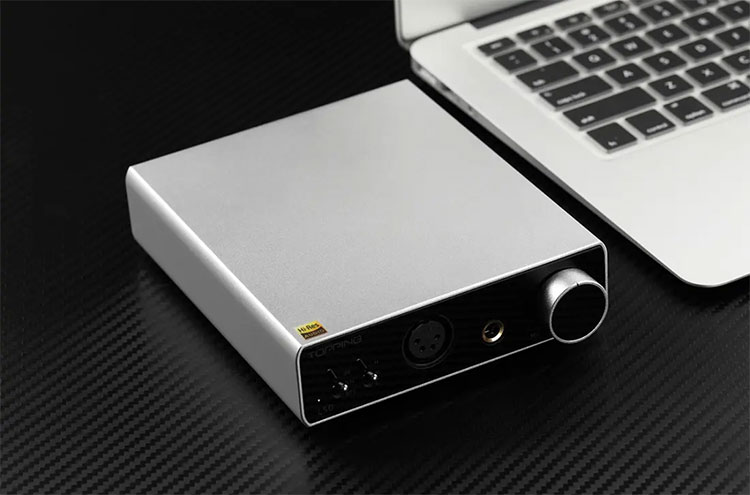
Our Verdict
With the E50, Topping opted to create a simple DAC while packing in the latest features available such as MQA capability, balanced outputs, and even an option to control the volume in such a small package. Perhaps, I would have wanted to see a more functional menu system without the need to keep reaching out for the remote control.
With the L50 on the other hand, Topping created a fully-featured balanced amplifier employing their NFCA topology packing in enough power to drive most headphones while maintaining control over sensitive loads. This makes the L50 a compelling option to drive a wide variety of headphones and IEMs in a small and simple package.
While the E50 and L50 needed to make some compromises like the ¼” balanced cable connection or the external power supply or lack of one with the E50, this is to keep both the price and size of both units down.
When it comes to sound, however, the E50 and L50 didn’t make any compromises, allowing the pair to create an honest and exciting presentation while staying away from sounding fatiguing.
Topping E50 & L50 Technical Specifications
Topping E50
- USB IN:
- PCM 44.1kHz-768kHz/16bit-32bit
- DSD DSD64-DSD512 (Native), DSD64-DSD256 (DoP)
- MQA Full Decoding
- COAX/OPT IN: PCM 44.1kHz-192kHz/16bit-24bit
- DSD DSD64(Dop)
- MQA Renderer Decoding
- Output Impedance: 20Ω(SE), 100Ω(BAL)
- THD+N: 0.00009%
Topping L50
- THD+N: <0.00006%
- DRN: 145dB
- Noise: <0.3uVrms
- Output Impedance: <0.1Ω
- Max output power: 3500mW x@16Ω, 540mW x@300Ω

